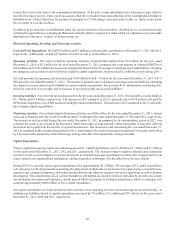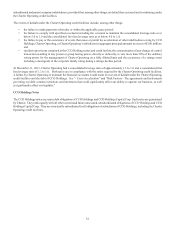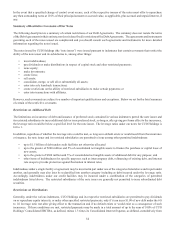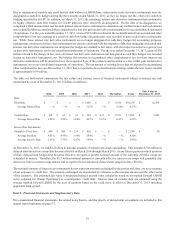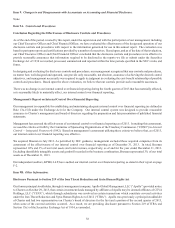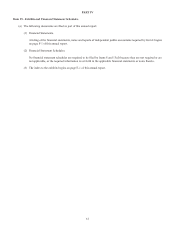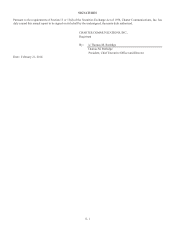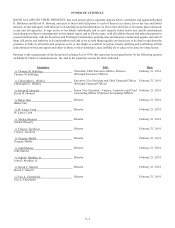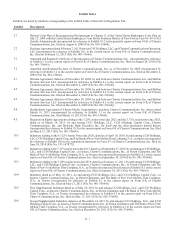Charter 2013 Annual Report Download - page 70
Download and view the complete annual report
Please find page 70 of the 2013 Charter annual report below. You can navigate through the pages in the report by either clicking on the pages listed below, or by using the keyword search tool below to find specific information within the annual report.56
Affiliate Transactions
The indentures also restrict the ability of CCO Holdings and its restricted subsidiaries to enter into certain transactions with affiliates
involving consideration in excess of $25 million without a determination by the board of directors that the transaction complies
with this covenant, or transactions with affiliates involving over $100 million without receiving an opinion as to the fairness to
the holders of such transaction from a financial point of view issued by an accounting, appraisal or investment banking firm of
national standing.
Cross Acceleration
The indentures of CCO Holdings include various events of default, including cross acceleration provisions. Under these provisions,
a failure by the note issuer or any of its restricted subsidiaries to pay at the final maturity thereof the principal amount of other
indebtedness having a principal amount of $100 million or more (or any other default under any such indebtedness resulting in
its acceleration) would result in an event of default under the indenture governing the applicable notes. As a result, an event of
default related to the failure to repay principal at maturity or the acceleration of the indebtedness under the CCO Holdings notes,
CCO Holdings credit facility or the Charter Operating credit facilities could cause cross-defaults under all of CCO Holdings'
indentures.
Recently Issued Accounting Standards
In June 2013, the Financial Accounting Standards Board's Emerging Issues Task Force reached a final consensus on Issue 13-C,
Presentation of an Unrecognized Tax Benefit when a Net Operating Loss or Tax Credit Carryforward Exists ("Issue 13-C"). Issue
13-C states that entities should present the unrecognized tax benefit as a reduction of the deferred tax asset for a net operating loss
or similar tax loss or tax credit carryforward rather than as a liability when the uncertain tax position would reduce the net operating
loss or other carryforward under the tax law. Issue 13-C requires prospective application (including accounting for uncertain tax
positions that exist upon date of adoption) with optional retrospective application and is effective for annual and interim periods
beginning after December 15, 2013, with early adoption permitted. The Company adopted Issue 13-C in the second quarter of
2013 and applied it retrospectively.
Item 7A. Quantitative and Qualitative Disclosures About Market Risk.
We are exposed to various market risks, including fluctuations in interest rates. We have used interest rate swap agreements to
manage our interest costs and reduce our exposure to increases in floating interest rates. We manage our exposure to fluctuations
in interest rates by maintaining a mix of fixed and variable rate debt. Using interest rate swap agreements, we agree to exchange,
at specified intervals through 2017, the difference between fixed and variable interest amounts calculated by reference to agreed-
upon notional principal amounts.
As of December 31, 2013 and 2012, the principal amount of our debt was approximately $14.2 billion and $12.9 billion, respectively.
As of December 31, 2013 and 2012, the weighted average interest rate on the credit facility debt, including the effects of our
interest rate swap agreements, was approximately 3.6% and 4.2%, respectively, and the weighted average interest rate on the high-
yield notes was approximately 6.4% and 6.7%, respectively, resulting in a blended weighted average interest rate of 5.6% and
6.0%, respectively. The interest rate on approximately 84% and 87% of the total principal amount of our debt was effectively
fixed, including the effects of our interest rate swap agreements, as of December 31, 2013 and 2012, respectively.
We do not hold or issue derivative instruments for speculative trading purposes. We, until de-designating in the first quarter of
2013, had certain interest rate derivative instruments that were designated as cash flow hedging instruments for GAAP purposes.
Such instruments effectively converted variable interest payments on certain debt instruments into fixed payments. For qualifying
hedges, realized derivative gains and losses offset related results on hedged items in the consolidated statements of operations.
We formally documented, designated and assessed the effectiveness of transactions that received hedge accounting.
Changes in the fair value of interest rate derivative instruments that were designated as hedging instruments of the variability of
cash flows associated with floating-rate debt obligations, and that met effectiveness criteria were reported in accumulated other
comprehensive loss. The amounts were subsequently reclassified as an increase or decrease to interest expense in the same periods
in which the related interest on the floating-rate debt obligations affected earnings (losses). For the years ended December 31,
2013, 2012 and 2011, gains of $7 million and losses of $10 million and $8 million, respectively, related to derivative instruments
designated as cash flow hedges, were recorded in other comprehensive loss.





